Mount Everest
Mount Everest highest in the world, the highest of the Himalayan mountains at an altitude of 8,848.86m/ 29031.69ft highest peak on the earth exactly located at 27.9881° N latitude and, 86.9250° E longitude in the Mahalangur Himal sub-range of the Himalayas.
MOUNT EVEREST
Mount Everest is probably the most popular mountain on Earth. It is certainly the highest in the world, the highest of the Himalayan mountains at an altitude of 8,848.86m. The summit sits on the border between Nepal and the Tibetan Autonomous Region of China and is called Sagarmatha in Nepali and the Sherpa and Tibetan languages, it is called Chomolungma or Qomolangma.
Witnessing a glimpse of Everest, trekking to its base, or even climbing to the mountain’s peak, is a bucket-list item for numerous adventurous travelers. There are numerous ways to see Everest, those who don’t want to trek can take scenic airplane and helicopter flights from Kathmandu or go overland to Everest Base Camp on the Tibet side of the mountain.

Mt. Everest can be seen and approached from either Nepal or Tibet, but tours from the Nepal side are most famous as the country is more accessible than the western reaches of China. No roads direct to Everest on the Nepali side, so most travelers fly from Kathmandu to Lukla and begin their trek from there. In Tibet, the road leads to Everest Base Camp.
The Himalayan mountains have long been native to indigenous groups living in the valleys. The most popular of these are the Sherpa people. The word “Sherpa” generally means mountain guide, though it is specific to an ethnic group. The Sherpa has significant experience in mountain climbing, which they can support other climbers. Most climbs of Everest would be unattainable without the Sherpas’ logistical help and knowledge. However, their way of life enhances beyond helping Everest climbers.
Traditionally, their style of living has consisted of farming, herding, and trade. And, because they live at such a high altitude year round, they are acclimatized to the low oxygen levels. The Everest region has been admired as the key to the evolutionary history of the Earth and is also a home for some rare and endangered species like the snow leopard, Himalayan black bear, red panda, musk deer, and Himalayan wolves.
The best season for Everest Base Camp Trek is spring (March, April, and May) and autumn (September, October, and November). Temperatures are very chill in the winter (December, January, and February), and routes and access to Lukla may not be regulars flight during the monsoon season (June, July, and August).
Due to the dense fog and bad weather, sightseeing flights to the Himalayas from Kathmandu can be canceled during the monsoons. Overland tours in Tibet can be taken at any time, but access is restricted in the winter due to safety concerns. The Everest region in Nepal is more than just climbing and trekking, it is a life-changing experience and some observe it as a journey close to accomplishing Nirvana.
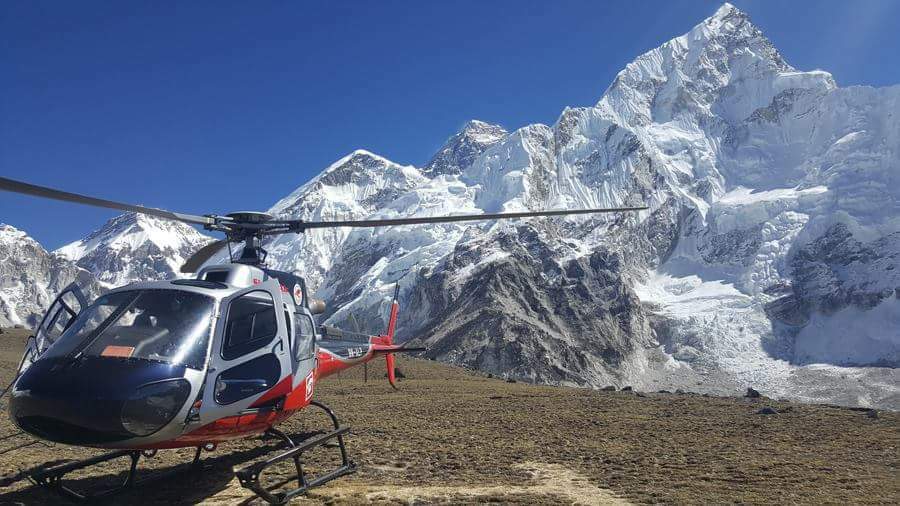 popular
popular
Everest Base Camp Helicopter Tour
$ 1300.0 $ 990.0
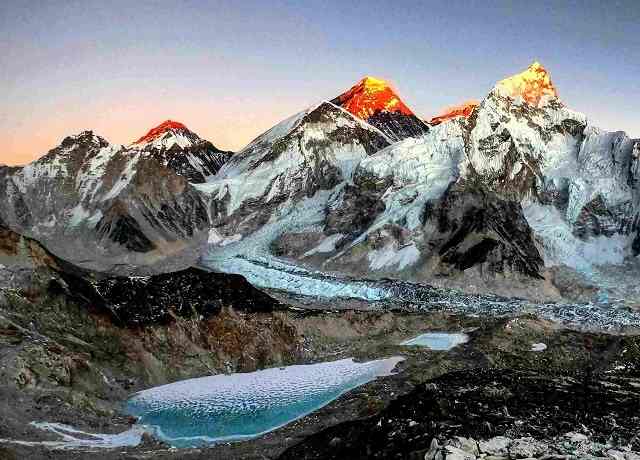 popular
popular
Everest Base Camp Trek 14 days | EBC Trekking
$ 1350.0 $ 1100.0
INFORMATION ABOUT MOUNT EVEREST
Mount Everest is the supreme peak in the world. The Sanskrit name Sagarmatha means “Peak of Heaven”. The name, Chomolungma, means “Goddess Mother of the World” or “Goddess of the Valley” in Tibetan.
Its existence as the peak point on the Earth’s surface was not identified until 1852 when the governmental Survey of India established that fact. In 1865, the mountain formerly referred to as Peak XV was renamed Sir George Everest, British surveyor general of India from 1830 to 1843. The first-ever certified people to ascend Everest was Edmund Hillary, a mountaineer from New Zealand, and his Tibetan guide Tenzing Norgay.
They climbed the mountain in 1953 and hold history together. The initial records of Everest’s height came much earlier, in 1856. In the Great Trigonometrical Survey of the Indian subcontinent, British surveyors listed that Everest was the highest peak in the world. There is very little native flora and fauna on Everest. Moss grows at 6,480 meters on Mount Everest.
It may be the highest-altitude plant species. Euphory's omnisuperstes, a tiny black jumping spider, has been found at an altitude as high as 6,700 meters, probably making it the highest confirmed non-microscopic everlasting resident on Earth.
Birds, such as the bar-headed goose, have been spotted flapping at the higher altitudes of the summit, while others, such as the chough, have been spotted as high as the South Col at 7,920 meters. Yellow-billed choughs have been spotted as high as 7,900 meters. And bar-headed geese shifted over the Himalayas.
Yaks are generally used to carry gear for Mount Everest climbs. They can carry 100 kg (220 pounds) have thick fur and have large lungs. One general piece of advice for those in the Everest region is to be on the greater ground when yaks and other animals are around, as they can blow people off the mountain if standing on the downhill corner of a trail.
Other animals in the region include the Himalayan tahr which is at times eaten by the snow leopard. The Himalayan black bear can be found up to around 4,300 meters (14,000 ft) and the red panda is also found in the region. Because Mount Everest is the crown mountain in the world, it has intrigued major attention and climbing attempts.
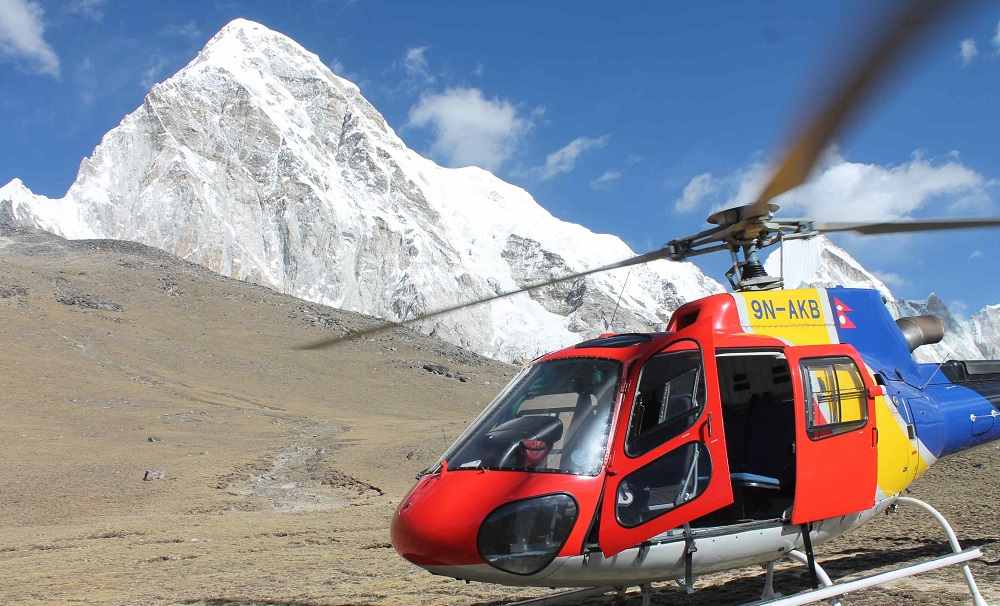 trending
trending
Everest Base Camp with Gokyo Lake Helicopter Tour
$ 1100.0
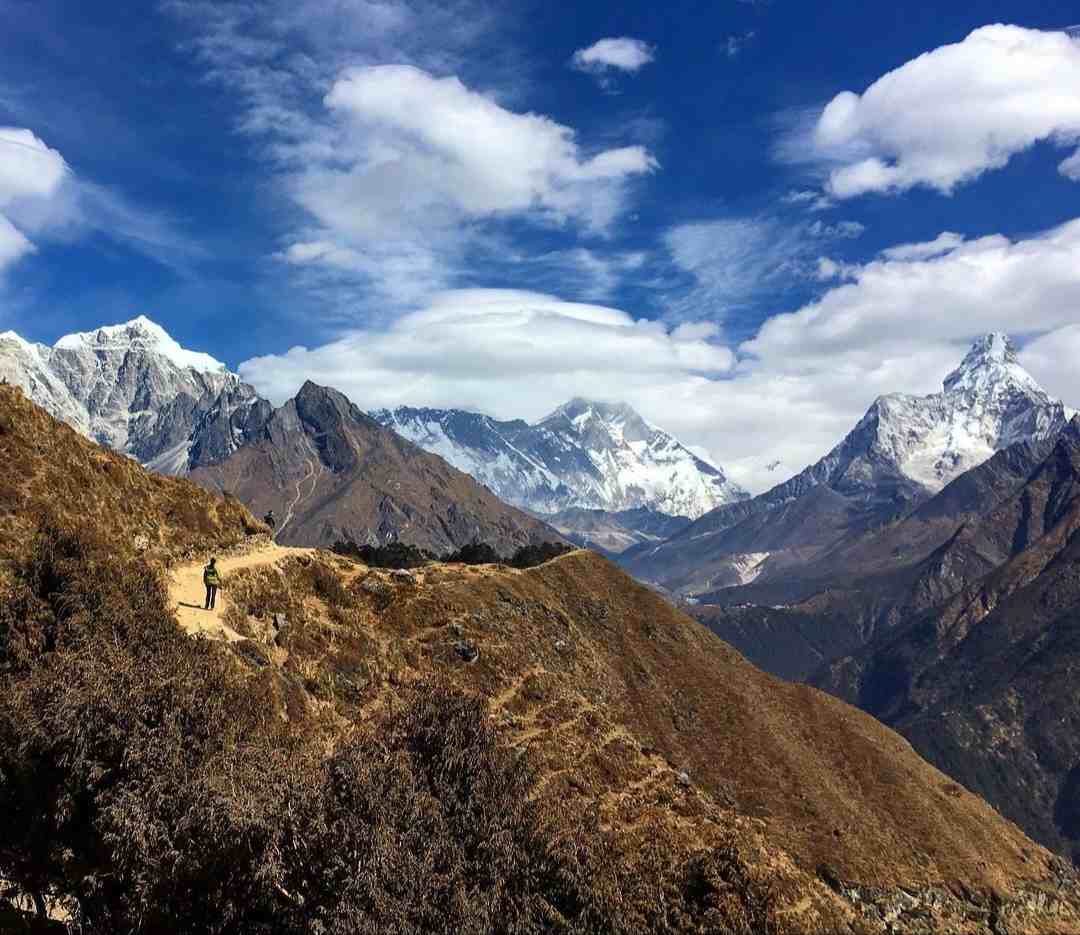
Everest View Trek
$ 1050.0 $ 790.0
MOUNT EVEREST LOCATION
Mount Everest is Earth's highest peak 8848.86m above sea level, exactly situated at 27.9881° N latitude and, 86.9250° E longitude in the Mahalangur Himal sub-range of the Himalayas. It is stationed on the border of Tibet and Nepal.
In Nepal, Mount Everest lies in the Solukhumbu district, which is in the northeastern sector of the country. The route through the base camp of Everest goes via the Sagarmatha National Park. In Tibet Autonomous Region, Mt. Everest outskirts of the Dhinggri County of the Xigaze region.
The Everest Base Camp that exists in Nepal is the South Base Camp. This base camp is more convenient to reach than North Base Camp in Tibet. Primarily, when people say they are traveling to Everest Base Camp, they mean from the Nepal side.
Mount Everest is the most towering mountain in the world. Numerous people all over the world wish to see this enormous peak closely. It is one of the major treasures of Nepal standing at a remarkable height of 8,848.86 meters. Each year, thousands of adventurers and trekkers trek to the base camp of Everest to witness the magnificent mountain in front of their bared eyes.
MOUNT EVEREST FACTS
- The Himalayan extension was boosted higher by tectonic action as the Indian-Australian Plate moved northward from the south and was forced down under the Eurasian Plate following the crash of the two plates between around 40 and 50 million years ago.
- The Himalayas themselves initiated rising about 25 to 30 million years ago, and the Great Himalayas lead to take their present form during the Pleistocene Epoch about 2,600,000 to 11,700 years ago.
- Everest and its surrounding mountains are part of an enormous mountain range that develops a focal point, or knot, of this tectonic action in the Great Himalayas. Information from global positioning instruments in place on Everest since the late 1990s demonstrates that the mountain pursues to move a few inches to the northeast and arise a fraction of an inch each year Everest is composed of numerous layers of rock folded back on themselves (nappes).
- Rock on the lower altitudes of the mountain subsists of metamorphic schists and gneisses, covered by sizzling granites. Sedimentary rocks of marine origin (remnants of the ancient floor of the Tethys Sea that closed after the collision of the two plates) are found up higher.
- Distinguished is the Yellow Band, a limestone composition that is particularly visible just below the peak pyramid. The arid Southeast, Northeast, and West ridges terminate at the Everest summit, a brief distance away is the South Summit, a small peak on the Southeast Ridge with an altitude of 8,748 meters.
- The mountain can be witnessed directly from its northeastern side, where it arises about 3,600 meters above the Plateau of Tibet. The crown of Changtse (7,560 meters) arises to the north. Nuptse (7,861 meters), Khumbutse (6,665 meters), and Lhotse (8,516 meters) surround Everest’s base to the west and south. Everest is formed like a three-sided pyramid.
- The three commonly flat planes composing the sides are called faces, and the line by which two faces unite is known as a ridge. The North Face arises above Tibet and is surrounded by the North Ridge (which meets the Northeast Ridge) and the West Ridge, key features of this side of the peak involve the Great and Hornbein couloirs (steep gullies) and the North Col at the beginning of the North Ridge.
- The Southwest Face arises above Nepal and is surrounded by the West Ridge and the Southeast Ridge, important features on this site include the South Col (at the start of the Southeast Ridge) and the Khumbu Icefall, the latest jumble of large blocks of ice that has long been a frightening challenge for climbers.
- The East Face or Kangshung (Kangxung) Face also arises above Tibet and is surrounded by the Southeast Ridge and the Northeast Ridge. The peak of Everest itself is enclosed by rock-hard snow-crowned by a layer of softer snow that changes annually by some 5–20 feet (1.5–6 meters).
- The snow level is highest in September, after the monsoon, and lowest in May after having been consumed by the strong northwesterly winter winds. The peak and upper slopes sit so high in the Earth’s atmosphere that the amount of breathable oxygen is one-third there than what it is at sea level. The deficiency of oxygen, powerful winds, and intensely cold temperatures hinder the development of any plant or animal life there
- The climate of Everest is forever unfriendly to living things. The warmest normal daytime temperature in July is only about −2 °F (−19 °C) on the summit and in January, the coldest month, peak temperatures normally are −33 °F (−36 °C) and can drop as low as −76 °F (−60 °C).
- Storms can come up abruptly, and temperatures can decrease unexpectedly. The peak of Everest is so extreme that it reaches the lower limit of the jet stream, and it can be hit repeatedly by constant winds of more than 100 miles (160 km) per hour. Rainstorm falls as snow during the summer monsoon (late May to mid-September). The risk of frostbite to climbers on Everest is intensely high.
LATEST HEIGHT OF MOUNT EVEREST
Mount Everest evolve by nearly a meter to its recent height. Nepal and China have jointly announced the world's highest peak Mount Everest is 0.86m higher than had been formerly officially estimated.
Till now the countries contradict over whether to sum the snow cap on top. The recent height is 8,848.86m (29,032 ft). China's earlier official measurement of 8,844.43m had put the mountain almost four meters lower than Nepal's.
Everest remains on the border between China and Nepal and mountaineers climb it from both sides. Officials at Nepal's foreign ministry and the Department of Survey aforementioned surveyors from both countries had harmonized to agree on the recent height.
The agreement to jointly disclose the new measurement of the Earth's highest point was made during Chinese President Xi Jinping's visit to the Nepalese capital, Kathmandu last year
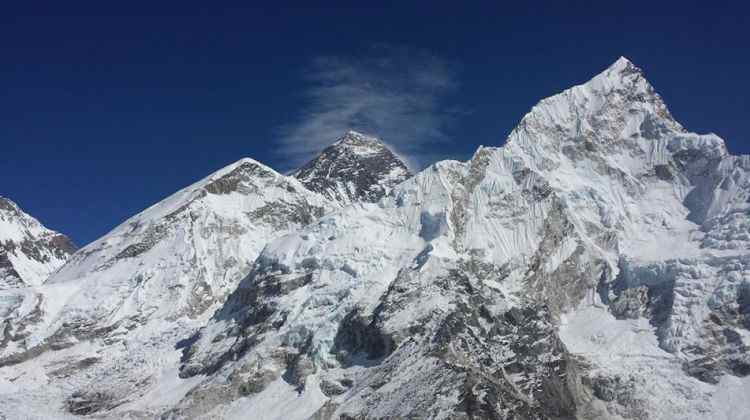
Everest Base Camp Luxury Lodge Trek
$ 2450.0
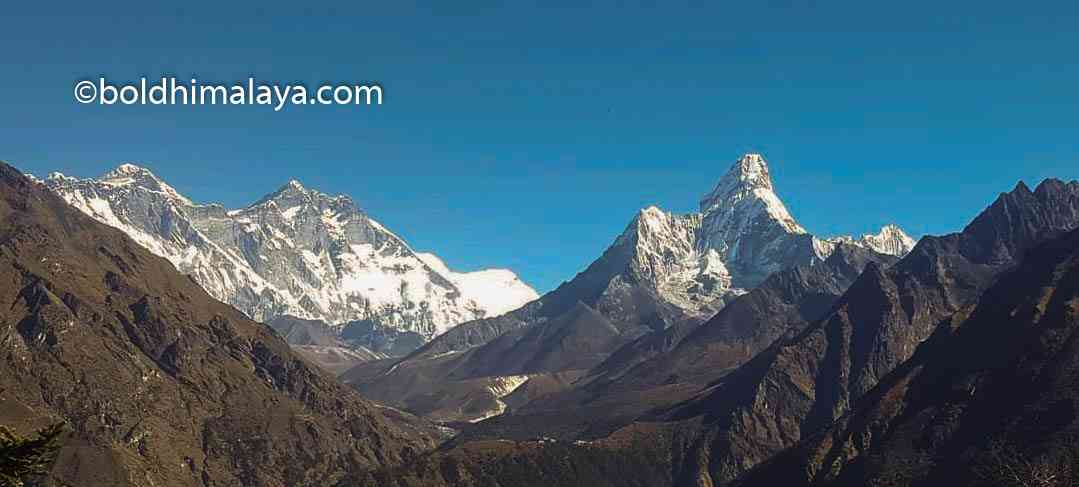
Luxury Everest View Trek | Everest Experience Luxury Trekking
Price on request
MORE INTERESTING FACTS ABOUT MOUNT EVEREST
Earth scientists evaluate that Everest is 50 to 60 million years old, a youngster by geological standards. The mountain was composed of the upward force created when the Indian and Eurasian tectonic plates crashed, pushing up the rocks that assembled the highest mountain on Earth.

That force is even at work today, forwarding Everest’s peak around a quarter of an inch taller every year. Some of the interesting facts about Mount Everest are as follows: ·There are more than 7000 summits on Everest: The first recorded person to reach the summit of Everest was in 1953. Since then, more than 4,000 distinct people have stood on the roof of Everest over 7,000 times.
Some of them (most are Sherpa guides) have climbed it more than a single time. ·Mount Everest is named after an Englishman: Mount Everest has been entitled after George Everest, the director of the governmental Survey of India from 1830 to 1843. He was the first person to systematize a team and measure the Himalayas Mountains. Thus, today we call it "Mount Everest"
.. In 1841, this great mountain was finally acknowledged for its distinctive feature. ·Radhanath Sikdar was the first person to discover Mt. Everest: Unlike how most people think, Mt Everest is not discovered by George Everest. Despite the mountain is entitled after George Everest, he was not the first one to recognize it as the tallest mountain in the world. Mt Everest was rather founded by an Indian, Radhanath Sikdar, an Indian surveyor and a mathematician.
·Mount Everest is in China and Nepal: Mt Everest is located between China and Nepal, China to the north, and Nepal to the south. It extends across from the wonderful regions of Tibet to beautiful Nepal.
·Little knew that male lions hide at Mount Everest Top: A lama told Tenzin Nogai (the Nepalese who first climbed Mount Everest) that according to the scriptures, there was a golden lion at the peak of Mount Everest. Tenzin Nogai did not catch sight of it because the golden lion was on the Tibetan side.
·Above 8000 meters region is called the death zone: From Camp 4 to the mountain peak, mountaineers enter what is often called the "death zone." Over 8,000 meters (26,247 feet), 95% of climbers will struggle with Oxygen deficiency and excess cold. Whereas, helicopters, rescue policies, and GPS devices will be definite.
·Over 300 people died on Mount Everest: Since the first successful reaching the summit in 1953, more than 300 people have died in the Himalayas, mostly Sherpa guides. Injury, hypothermia, altitude sickness, are the major three causes and chiefly during coming down.
·Edmund Hillary was the first person to reach the peak: The first people who climbed Mount Everest peak were Edmund Hillary from New Zealand and Tenzing Norgay from the Sherpa tribe of Nepal. They climbed the Everest summit from the Nepal borders on May 29. Originally, Colonel John Hunt was the one to lead a British expedition to ascend Everest peak. Hillary and Tenzing were a part of this journey. Ultimately, they became the first ones that could prosperously cover all the distance.
·The first woman to climb Mt. Everest, Junko Tanabe: On May 16, 1975, Japanese Junko Tanabe ascended from the south slope and became the first woman to climb Mount Everest in the world. In the identical year, Tibetan Pando became the first woman to ascend from the northern slope. ·Wedding on the summit: A Nepalese couple performed their marriage at the summit of Everest, being the first ones to do so.
Moni Mule Pati and Pem Dorjee Sherpa did not reveal their purpose until they reached the peak where they spent around 10-15 minutes which was sufficient to carry out the essential ceremony of the wedding.
·The first tweet from the top of the world: Kenton Cool made the initial tweet utilizing his handset from the peak of Mount Everest using a faint 3G signal. The tweet declared “Everest summit no 9" the first tweet from the top of the world thanks to a weak 3G signal and the amazing Samsung Galaxy S2 handset, @samsunguk. Even though the internet is weak and not widespread around the base camp or the peak, most tea houses and lodges along the way support the internet with good strength.
·Helicopter landing at Everest Summit: The high altitude and thin air make it difficult for choppers to gain the required elevation. Likewise, the winds and turbulence at that elevation are horrible for aircraft. Nevertheless, Didier Delsalle, a French pilot became the first person to land at the peak using a helicopter. The chopper was an AS350 series of the Airbus family, and the developers stripped the helicopter down to make it compatible with the experiment.9 ·Everest evolves 4mm higher every year due to geological uplift.
·Over 4,000 people have attempted to climb Everest. ·Mount Everest is also home to a very small black jumping spider. These spiders disguise in cracks and feed on frozen insects. Their food relies largely upon what is blown by the wind into the particular area. They live as high as 22,000 feet.
·The youngest person to reach the summit was 13, American Jordan Romero and the oldest was 80, Yuichiro Miura of Japan (the same guy who skied Everest in 1971).
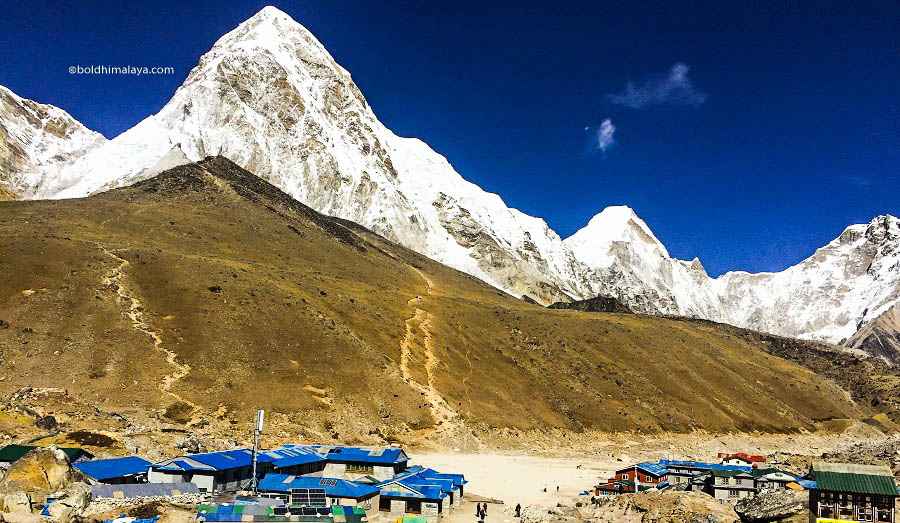
Everest Base Camp 11 Days Trek
Price on request
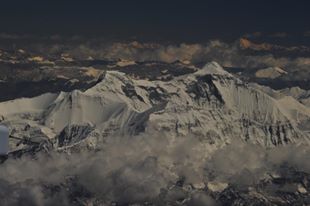 popular
popular
SOME REMARKABLE NEWS AND EVENT OF MOUNT EVEREST
Nepal has outlawed two Indian climbers and their team leader from carrying out any mountaineering expeditions in the country for six years after an investigation found that they faked their Mount Everest summit in 2016 ·Nepal celebrates Mt.
Everest Day on May 29 each year in remembrance of the first summit of Mt. Everest by Sir Edmund Hillary and Tenzing Norgay Sherpa in 1953. The day is celebrated with dedicatory events, successions, and distinctive events in Kathmandu and the Everest region.
The Mt. Everest Day celebration has been a meaningful occasion for the publicity of Nepal’s mountain tourism. Participants involve ministers, climbers, tourism entrepreneurs, and government officials.
Mount Everest summit accomplishment rates two times, and the death rate stays identical over the last 30 years.
The world's highest mountain is officially a little higher at the moment, and this might not be the limit of the story.
The mountain's height changes. The displacement of tectonic plates can lift it ever so moderately, whereas earthquakes can bring it down. Nepal and China cooperatively bestowed a fresh official figure of 8,848.86 meters (29,031.69 feet) above sea level.
The two had disagreed for years over the mountain's absolute height.
DISCOVERY AND NAMING OF MOUNT EVEREST
During the 19th century the Great Trigonometric Survey of British India discovered a mountain in the himalaya region between Tibet and Nepal. It was initially called "Gamma" before being renamed to "Peak B" in 1847. There were suspicions that this peak, later known as "Peak XV " might be taller than Kangchenjunga, previously believed to be the world's tallest mountain. After measurements and surveys the height of "Peak XV" was confirmed and announced as the tallest mountain of the world. This led to its name change, to "Mount Everest”, in 1856. The Royal Geographic Society officially adopted the name "Mount Everest" in 1865 at the suggestion of Andrew Waugh, who succeeded Sir George Everest as the British Surveyor General of India. In the century Swedish explorer Sven Hedin uncovered that Mount Everest was also known by the Tibetan name Cha mo lung ma or Qomolangma meaning "Goddess Mother of the World " while Nepali locals referred to it as Sagarmatha meaning "Goddess of the Sky."
HOW WAS MOUNT EVEREST FORMED?
Mount Everest was created through a collision, between the Indian and Eurasian tectonic plates millions of years ago. This collision caused the land to fold and rise forming a stretch of mountains spanning 1,500 miles known as the Himalayas. Although there are still unknowns, about the processes involved in this collision the impact is still ongoing contributing to the changing altitude of Everest even now.
Around 200 million years ago the journey of formation of the Himalayas started when the supercontinent Pangea started breaking. The Indian plate made its way, towards Asia at a pace, in geological terms moving around 30 feet or more every century.
The underwater plate, composed of crust descended below the southern boundary of the Eurasian continental plate resulting in the formation of a subduction zone. As the oceanic slab slowly moved into the mantle it scraped a layer of seafloor sediments to accumulate at the edge of the plate—this sandy layer would eventually undergo pressure to transform into rock and settle on the towering peaks.
The majestic Great Himalayas started shaping their form during the Pleistocene Epoch ( 2,600,000 to 11,700 years ago). Mount Everest and its neighboring peaks are part of a mountain range that acts as a point or hub, for tectonic activities in the Great Himalayas. Data from positioning devices positioned on Everest since the late 1990s reveal that the mountain continues to shift towards the northeast and uplift, by a small amount each year.
LANDSCAPE AND GEOLOGY OF MOUNT EVEREST
Everest is made up of layers of rock that have been folded over time. The lower parts of the mountain are composed of schists and gneisses followed by granites. Moving higher one can find limestone rocks.
The barren Southeast, Northeast and West ridges lead to the summit of Everest; nearby is the South Summit, an elevation on the Southeast Ridge reaching 28,700 feet (8,748 meters). The mountains northeastern side offers a view where it towers 12,000 feet (3,600 meters) above the Plateau of Tibet. To the north stands Changtses peak. Khumbutse, Nuptse and Lhotse form a ring around Everests base, to the west and south.
Mount Everest has a shape resembling a three pyramid. The side facing north extends over Tibet. Is bordered by the North Ridge and the West Ridge. Its prominent attractions consist of the Hornbein couloirs ( gullies) and the North Col, at the commencement of the North Ridge. On the hand the Southwest Face overlooks Nepal showcasing landmarks such as the South Col (at the beginning of the Southeast Ridge) and the Khumbu Icefall, which is a chaotic mass of large ice blocks that has long posed a formidable challenge, for mountaineers.
The peak of Mount Everest is covered with snow that varies in depth each year by about 5 to 20 feet (1.5 to 6 meters). This snowy covering reaches its peak thickness in September post monsoon. Thins out by May due, to the winter winds blowing from the northwest. Located at altitudes in Earths atmosphere the oxygen levels at the summit are only about one third of what they are at sea level. The harsh conditions, at this height, including oxygen levels, fierce winds and freezing temperatures make it impossible for any plant or animal life to thrive there.
MOUNTAINEERING HISTORY OF THE EVEREST
The initial individuals to make an attempt, at scaling Mount Everest set off in 1921. Two expeditions led by teams in 1921 and 1922 were unsuccessful in their efforts to reach the peak of Mount Everest. During the 1924 expedition George Mallory and Andrew Irvine members of a team were last spotted before encountering weather conditions. Tragically in 1924 George Mallory and Andrew Irvine along, with two Sherpas lost their lives. Records indicate that the expedition reached an altitude of 8,600 meters with plans to summit the following day and leave a photograph of Mallorys wife atop Mt. Everest. Communication had been lost since that point.
In May 1999, the American climber Conrad Anker found the corpse of George Mallory and the things that he collected concluded that Mallory and Irvin could have reached the summit. The most important proof that was missing was the fact that Mallory's wife's picture was not found, which he promised to leave at the top Of Mt. Everest if he could take the summit. So it can not be concluded that George Mallory was able to climb mount Everest.
Since 1924 numerous unsuccessful tries were made to summit Everest in the years 1933, 1935, 1936 and 1938. The Everest expedition was then put on hold due, to World War II. Following the wars conclusion a team of mountaineers led by Edmund Hillary and Tenzing Norgay Sherpa made near ascents in both the spring and autumn of 1952 reaching heights, up to 8500 meters.
FIRST PERSON TO CLIMB MOUNT EVEREST
In 1953, Sir Edmund Hillary and Tenzing Norgay Sherpa became the first individuals to successfully reach the summit of Mount Everest. Their conquering ascent not only made history but also paved the way for future generations of trekkers and climbers.
1996 MOUNT EVEREST DISASTER
The tragic events, on Mount Everest in 1996 took place over May 10 11 claiming the lives of eight climbers who were caught in a blizzard while descending from the summit. Throughout that season a total of 12 individuals lost their lives in pursuit of reaching the peak marking it as one of the seasons on Mount Everest up, to that point. This disaster garnered media attention. Sparked discussions regarding the commercialization of Everest.
Many climbers were caught in a storm, at altitudes on Mount Everest with the Adventure Consultants group under the leadership of Rob Hall and the Mountain Madness team led by Scott Fischer being among them. Tragic fatalities occurred on both the North Face and South Col routes. The incidents on the South Col route received media coverage. The Adventure Consultants expedition lost four members, including Rob Hall while Scott Fischer was the casualty from the Mountain Madness team. Additionally three officers, from the Indo Tibetan Border Police also lost their lives during this event.
NOTABLE CLIMBERS WHO DIED ON EVEREST
Green Boots Mount Everest (Tsewang Paljor)
One of the known climbers who met their fate on Mount Everest is Green Boots believed to be Tsewang Paljor. He tragically lost his life during the fated 1996 expedition, on Everest that involved the Indo Tibetan Border Police team from India. The nickname "Green Boots" comes from the green Koflach mountaineering boots he was wearing at the time. Paljor and his companions encountered a blizzard just shy of reaching the summit. While three members of the team decided to turn Paljor and two others chose to push but unfortunately never returned. Green Boots served as a landmark along the Northeast ridge route until his remains were eventually relocated in 2014. The disaster in 1996 resulted in the loss of eight climbers. Sparked concerns about the commercialization of expeditions, on Everest.
Sleeping Beauty Mount Everest (Francys Arsentiev)
Francys Arsentiev was an experienced climber who lost her life on Everest in May 1998. She and her husband, Sergei Arsentiev, were attempting to summit without supplemental oxygen. Despite reaching the summit, difficulties on the descent proved fatal for both, with HACE (high-altitude cerebral edema) likely contributing to their deaths. Francys’ final words, “Don’t leave me,” added a deeply human element to the tragedy.
Fancys gained the nickname “Sleeping Beauty of Everest” due to her striking appearance. As she lay on the mountain, she looked as peaceful as if she were asleep. The harsh conditions had left her skin pale and waxen. After nine years, her body was finally discovered and recovered in 2007.
George Mallory
George Mallory, a climber went missing, on his 1924 expedition to Mount Everest. It wasn't until 1999 that his remains were finally located, leading to speculation, about the circumstances of his moments.
Reports indicate that he likely fell to his death as recovery efforts uncovered head injuries and rope related trauma around his waist. Mallory had promised to place a picture of his spouse, at the peak. It was never discovered, adding to the enigma of whether he and his climbing companion, Andrew Irvine conquered the summit before meeting their fate.
Scott Fischer
Scott Fischer, an mountaineer and guide tragically lost his life during the well known Everest disaster of 1996. Leading the Mountain Madness expedition, among teams striving for the summit that day he unfortunately succumbed to HACE during the descent after a late afternoon summit success. Despite the attempts of climbers and Sherpas to aid him he sadly passed away close, to the South Summit.
David Sharp
In 2006 David Sharp, a climber tragically lost his life while trying to climb Mount Everest. He faced hypothermia altitude sickness and lack of oxygen, on the north side of the mountain. Although than 40 climbers passed him on the night he died a handful offered assistance sparking debates about ethical responsibilities, in such circumstances.
Hannelore Schmatz
Hannelore Schmatz became the woman to reach the summit of Mount Everest and tragically she was also the first woman to lose her life on the mountain. In 1979 during an expedition, with her husband she passed away in a bivouac to the peak. Despite their Sherpa guides urging them to move they chose to remain in that spot facing weather conditions that proved fatal. Initially serving as a marker on the mountain her remains eventually disappeared over time due, to forces.
Shriya Shah-Klorfine
Shriya Shah-Klorfine was a Nepali-born Canadian mountaineer who died on Everest in 2012. Her summit attempt coincided with a crowded season, and she became caught in bottlenecks on the way to the top. Despite reaching the summit, exhaustion and lack of oxygen proved too much on the descent.
MOUNT EVEREST DEATH ZONE
A region known as the death zone begins at an altitude of 8000 meters where oxygen levelsre insufficient and atmospheric pressure is significantly low. Human survival, beyond a days in this environment is not possible even with the use of an oxygen tank. The decreased pressure hampers the bodys ability to effectively bind oxygen to hemoglobin leading to conditions, like edema and cerebral edema. At altitudes exceeding 8000 meters the body struggles to intake nourishment resulting in an energy balance.
RAINBOW VALLEY MOUNT EVEREST
In the northeastern ridge region of the mountain there's a spot called Rainbow Valley that holds importance, for climbers using the North Col route. Its not named for its beauty but for the down jackets left behind by unfortunate climbers. Over the years, around 300 individuals have lost their lives trying to conquer Mount Everest. About 200 of them remain on the mountain to this day.
MOUNT EVEREST BASE CAMP
There are two campsites situated at the foot of Mount Everest, each located on sides of the mountain; The South Base Camp can be found in Nepal at an elevation of 5,364 meters (17,598 ft) while the North Base Camp is positioned in Tibet at 5,150 meters (16,900 ft). Mountain climbers utilize these camps during their journey up and, down the mountain. They are also spots for hikers to visit. The South Base Camp serves as a starting point for climbers taking the southeast ridge route whereas the North Base Camp is used by those following the northeast ridge path. Supplies are transported to the South Base Camp by porters and animals like yaks while a paved road branching off China National Highway 318 provides access, to the North Base Camp. Climbers typically spend days acclimatizing at base camp to reduce their risk of altitude sickness.
MOST FREQUENT QUERIES
Where is Mount Everest
Mount Everest stands tall within the mountain range situated between Nepal and Tibet a region of China. Standing at a height of 8,849 meters (29,032 feet) it holds the title of being Earths highest peak.
How tall is Mount Everest
The first discovered height of Mount Everest was 8848 meters which was established in 1955AD. But upon recent investigation by joint effort of Nepal and India, the new height is found to be 8848.86 m.
How long does it take to climb Mount Everest?
Climbing Mount Everest usually requires around two months. This duration encompasses periods for adjusting to the altitude taking rest days and making the push, towards the summit. Climbers dedicate weeks to getting used to the altitudes at different camps along the path to prevent altitude sickness and ready themselves for the harsh environments, at greater heights.
How much does it cost to climb Mount Everest?
An adventure, to Mount Everest can set you back from $30,000 to $60,000 or even more. This price usually covers permits, logistics, the services of guides, meals, lodging, oxygen supply, gear and other essential expenses.
Many climbers opt to join guided teams arranged by mountaineering companies. These companies handle most of the planning aspects such as permits, transportation, accommodation and safety gear. This convenience can significantly raise the expenses. Also ensures a higher level of assistance and security.
On the hand independent climbers who plan their expeditions may have the opportunity to cut down on costs. However they also bear responsibilities for organizing logistics ensuring safety measures are in place and coordinating aspects – tasks that can be quite daunting and risky, on such a challenging mountain.
What country is Mount Everest in?
Mount Everest is located in Nepal.
How many people have climbed Mount Everest?
Since 1953 a total of 11,996 climbs have been made to the summit of Mount Everest up, to January 2024 covering all paths by 6,664 individuals.
How many dead bodies are on Mount Everest?
As per the climbing community, 300 individuals have lost their lives while attempting to climb Mount Everest. It is believed that 200 bodies still remain on the mountain, some of which are visible while others are lost without a trace.
Who was the first person to climb Mount Everest?
Tenzing Norgay Sherpa and Sir Edmund Hillary were the first person to climb to the top of Mount Everest.
What is the main cause of death of people while climbing Mount Everest?
Many people tragically perish during Mount Everest expeditions as a result of injuries, exhaustion, and the dangers posed by avalanches and crevasses, at altitudes. Moreover, a significant number of climbers are affected by altitude-related conditions, like altitude cerebral edema (HACE) and high altitude pulmonary edema (HAPE) further adding to the risks faced on the mountain.
How many people climb Mount Everest every year?
About 800 people try to climb the mount Everest every year.